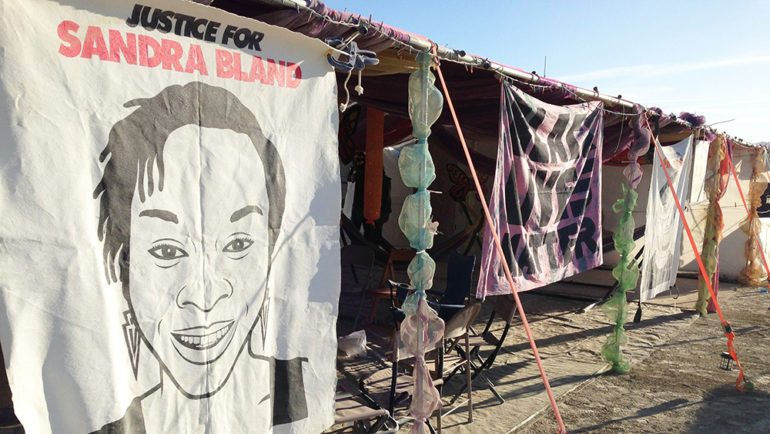‘Say Her Name’ Directors Discuss Importance of Showing Sandra Bland’s ‘Humanity’ Amid Tragedy
By Danielle Turchiano
LOS ANGELES (Variety.com) – Sandra Bland went viral after dashboard camera footage showed state trooper Brian Encinia pulling her over for failing to signal while driving, and ultimately threatening to “light [her] up” and trying to pull her out of the car. But well before that 2015 incident, which ultimately led to her dying under mysterious circumstances in a jail cell, she was using social media to empower and educate. That is why filmmakers Kate Davis and David Heilbroner, who directed “Say Her Name: The Life and Death of Sandra Bland,” wanted to start their documentary about her with one of her own videos.
In a piece that Bland originally shared on her Instagram account, she opens “Say Her Name” by saying, “Today #SandySpeaks is going to talk about white people.” It is a moment, Heilbroner points out, that often gets a laugh from the audience because it’s “an immediate disarming, witty side” of the woman. But the video goes deeper to ultimately discuss why it’s “really hard to be black in America,” which Heilbroner notes is “weirdly prescient” when one considers what happened to her.
“There are far too many cases like Sandy’s case where people ultimately die at the hands of law enforcement in a racially charged encounter, but they become a name on a list and their humanity is lost. Sandra gave us a really amazing opportunity to portray someone in three dimensions,” Heilbroner tells Variety. “It allows us an in and makes us pause to acknowledge her humanity, and that is something I think needs to happen if we’re going to get out of this terrible cycle.”
As the film goes on, Davis and Heilbroner continue to mix in Bland’s videos, often in extreme emotional turns, such as using a lighter piece about hair moments before showing the footage of her getting arrested. “Sandy had a great range as a person, so we wanted to do justice to all of the different facets of her character,” Heilbroner says.
Davis and Heilbroner reached out to Bland’s family “in the very early days of the case” in which the Harris County grand jury was looking into law enforcement’s culpability in Bland’s death. The documentarian duo worked carefully to “help them tell their story,” but because details and new evidence were unfolding in real life as they were filming, the challenge became “interweaving tracking the family’s own emotional journey and punctuating that with Sandra’s own voice,” says Davis.
Davis shares that she and Heilbroner did go into the film with “a civil rights agenda” because of just how prevalent violent and unjust treatment, particularly to people of color on the street by law enforcement, was, but they did not set out to make a “gotcha film.”
“We weren’t out to villainize the sheriff or the D.A. at all — that’s just going to polarize people. I don’t think it’s going to be helpful for the dialogue around racism and law enforcement. It would just get everyone’s walls up, and that’s exactly what Sandy talks about in the film — that we need to listen to each other,” she says.
And since they wanted to “give everybody a fair hand” in the way the story was portrayed, Davis continues, they had to also approach interviewing those on the law enforcement side, such as Waller County Sheriff R. Glenn Smith, with just as open a mind as they did Bland’s family and friends. In doing so, both Davis and Heilbroner admit they were surprised by just how honest law enforcement officials such as Smith were with them.
“There are some moments in the film where they really do cop to [some things],” Davis says, adding that she and Heilbroner wanted to present their statements but “let the audience decide for themselves about whether they think they’re being honest or covering up something.”
Adds Heilbroner, “There are a lot of factual revelations throughout the film which create a tremendous sense of both mystery about what happened, but also reinforce that whatever happened to Sandra Bland was a result of essentially a woman being ganged up on by the system — whether someone came in there and strangled her … or whether the system falsely arrested her, beat her up by the roadside, put her in jail on bogus charges, threw her in solitary confinement, didn’t check on her the way they were supposed to.”
Those who have followed Bland’s story in the news already know how “Say Her Name” will end. But in addition to following the facts, the goal of “Say Her Name” was to ask its audience to “take a look in a mirror and realize we all have biases and triggers that we’re unaware of and can behave in ways, however well intended, that can have very, very dire consequences,” says Heilbroner.
“Sandy said [she was] going to keep calling out racism,” Davis points out. “That was a brave act. She was, in a sense, the Rosa Parks of this generation. It’s a message of bravery, of courage, of standing up to power, of not demonizing the other, but trying to work with them.”
“Say Her Name: The Life and Death of Sandra Bland” airs Monday at 10 p.m. on HBO.

